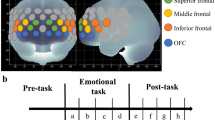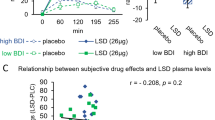Abstract
An earlier study (Borg et al., Am J Psychiatry 2003) found an inverse correlation between [carbonyl-11C]WAY-100635 ligand binding to 5-HT1A receptors and scores for self-transcendence, but no other of the six dimensions of the Temperament and Character Inventory, in a group of healthy males. The aim of this study was to investigate if the finding of an inverse correlation between spirituality and 5-HT1A could be seen in patients suffering from major depressive disorder or replicated among healthy volunteers. A total of 23 patients with major depressive disorder and 20 healthy volunteers were examined with PET using [carbonyl-11C]WAY-100635 as the radioligand. The personality traits were measured using the Finnish version of the Temperament and Character Inventory and correlated with ligand binding (BP). No significant correlations were found between the different Temperament and Character Inventory subscales and BP in any of the studied brain regions (amygdala, anterior cingulate cortex, dorsal raphe nuclei, dorsolateral prefrontal cortex, angular gyrus, inferior, middle, and superior temporal gyri, medial prefrontal cortex orbitofrontal cortex, hippocampus, insular cortex, subgenual anterior cingulate cortex, supramarginal gyrus, ventrolateral prefrontal cortex, and posterior cingulate cortex). These results do not support the idea that the serotonin system forms the biological basis of spiritual experiences among patients suffering from major depressive disorder or among healthy volunteers.
This is a preview of subscription content, access via your institution
Access options
Subscribe to this journal
Receive 12 print issues and online access
$259.00 per year
only $21.58 per issue
Buy this article
- Purchase on Springer Link
- Instant access to full article PDF
Prices may be subject to local taxes which are calculated during checkout

Similar content being viewed by others
References
Borg J, Andrée B, Söderström H, Farde L . The serotonin system and spiritual experiences. Am J Psychiatry 2003; 160: 1965–1969.
Hansenne M, Reggers J, Pinto E, Kjiri K, Ajamier A, Ansseau M . Temperament and character inventory (TCI)and depression. J Psychiatr Res 1999; 33: 31–36.
Josefsson A, Larsson C, Sydsjö G, Nylander P-O . Temperament and character in women with postpartum depression. Arch Womens Ment Health 2007; 10: 3–7.
Drevets WC, Thase ME, Moses-Kolko EL, Price J, Frank E, Kupfer DJ et al. Serotonin-1A receptor imaging in recurrent depression: replication and literature review. Nucl Med Biol 2007; 34: 865–877.
Hirvonen J, Karlsson H, Kajander J, Lepola A, Markkula J, Rasi-Hakala H et al. Decreased brain serotonin 5-HT1A receptor availability in medication-naïve patients with major depressive disorder—an in vivo imaging study using PET and [carbonyl-11C]WAY-100635. Int J Neuropsychopharmacol 2008; 11: 465–476.
Hirvonen J, Kajander J, Allonen T, Oikonen V, Någren K, Hietala J . Measurement of serotonin 5-HT1A receptor binding using positron emission tomography and [carbonyl-11C]WAY-100635—considerations on the validity of cerebellum as a reference region. J Cereb Blood Flow Metab 2007; 27: 185–195.
Friston KJ, Holmes AP, Worsley KJ, Poline JP, Frith C, Frackowiak RSJ . Statistical parametric maps in functional imaging: a general linear approach. Hum Brain Mapp 1995; 2: 189–210.
Innis RB, Cunningham VJ, Delforge J, Fujita M, Gjedde A, Gunn RN et al. Consensus nomenclature for in vivo imaging of reversibly binding radioligands. J Cereb Blood Flow Metab 2007; 27: 1533–1539.
Lammertsma AA, Hume SP . Simplified reference tissue model for PET receptor studies. Neuroimage 1996; 4: 153–158.
Cotton S, Larkin E, Hoopes A, Cromer BA, Rosenthal SL . The impact of adolescent spirituality o depressive symptoms and health risk behaviours. J Adolesc Health 2005; 36: 529.
McCullough ME, Larson DB . Religion and depression: a review of the literature. Twin Res 1999; 2: 126–136.
Brandstrom S, Schlette P, Przybeck TR, Lundberg M, Forsgren T, Sigvardsson S et al. Swedish normative data on personality using the Temperament and Character Inventory. Compr Psychiatry 1998; 39: 122–128.
Acknowledgements
The study was financially supported by Signe and Ane Gyllenberg Foundation, The Social Insurance Institution of Finland, and the Turku University Central Hospital (Grant P3848). The staffs of Turku PET Centre and the MRI Unit of Turku University Central Hospital are acknowledged for skillful assistance in performing PET and MRI scanning.
Author information
Authors and Affiliations
Corresponding author
Rights and permissions
About this article
Cite this article
Karlsson, H., Hirvonen, J., Salminen, J. et al. No association between serotonin 5-HT1A receptors and spirituality among patients with major depressive disorders or healthy volunteers. Mol Psychiatry 16, 282–285 (2011). https://doi.org/10.1038/mp.2009.126
Received:
Revised:
Accepted:
Published:
Issue Date:
DOI: https://doi.org/10.1038/mp.2009.126



